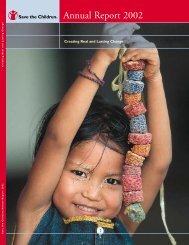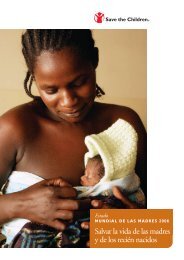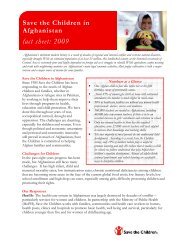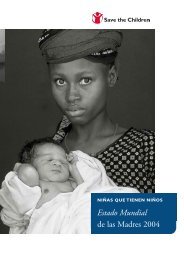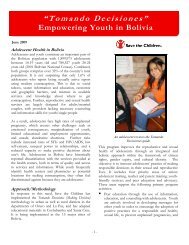The Power and Promise of Girls' Education - Save the Children
The Power and Promise of Girls' Education - Save the Children
The Power and Promise of Girls' Education - Save the Children
Create successful ePaper yourself
Turn your PDF publications into a flip-book with our unique Google optimized e-Paper software.
Studying for a Better Future<br />
<strong>The</strong> children <strong>of</strong> Oruro – a town high in Bolivia’s Altiplano – are some <strong>of</strong> <strong>the</strong> poorest in all <strong>of</strong><br />
South America. For decades, educational achievement, nutritional status <strong>and</strong> life expectancy<br />
have been below <strong>the</strong> st<strong>and</strong>ards for <strong>the</strong> rest <strong>of</strong> South America, <strong>and</strong> for Bolivia as a whole.<br />
Things are changing in Bolivia now, <strong>and</strong> 10-year-old Daniela is just one example <strong>of</strong> how girls’<br />
education is contributing to a brighter future. A generation ago, chances are that Daniela<br />
would have been among <strong>the</strong> 70 percent <strong>of</strong> indigenous girls who never completed primary<br />
school. Today, she is an enthusiastic fifth grader in <strong>the</strong> Carmen Guzmán de Mier School, which<br />
is supported by <strong>Save</strong> <strong>the</strong> <strong>Children</strong>, <strong>and</strong> Daniela has her sights set on a pr<strong>of</strong>essional career.<br />
“My favorite subjects are ma<strong>the</strong>matics <strong>and</strong> technology,” says Daniela.“And I enjoy <strong>the</strong><br />
multiple-purpose classroom, which we call <strong>the</strong> library. It has games <strong>and</strong> books that we can<br />
use. If I weren’t studying, I would have to go to <strong>the</strong> field to take care <strong>of</strong> sheep just like my<br />
friend Marlene. She does not go to school <strong>and</strong> she does not speak Spanish.”<br />
“When I grow up, I want to be a lawyer or an engineer. If I don’t study I will have to work as<br />
a household servant in o<strong>the</strong>r people’s homes. I want my life to be different than my mo<strong>the</strong>r’s<br />
life.” Daniela expects that when she becomes a pr<strong>of</strong>essional, she will have enough money to<br />
help her family <strong>and</strong> pay for health care if she gets sick. She would like to get married when<br />
she is 25 <strong>and</strong> have two children, a boy <strong>and</strong> a girl.“When I have children, <strong>the</strong>y will have better<br />
opportunities than I did, because I will educate <strong>the</strong>m.”<br />
“It’s important that girls<br />
<strong>and</strong> boys receive <strong>the</strong> same<br />
education, because it helps us<br />
to learn to work toge<strong>the</strong>r,”<br />
says Daniela, a fifth-grader in<br />
Oruro, Bolivia.<br />
provided to supplement family income <strong>and</strong> <strong>of</strong>fset <strong>the</strong><br />
direct <strong>and</strong> indirect costs <strong>of</strong> schooling. Bilingual teaching<br />
materials were distributed <strong>and</strong> bilingual teachers were<br />
trained so that monolingual indigenous children would<br />
have a smoo<strong>the</strong>r transition from home to <strong>the</strong> school<br />
environment. And school schedules were revamped<br />
so that school days would not coincide with <strong>the</strong> busy<br />
harvest season when children are frequently<br />
Methodology: <strong>The</strong> following indicators were used to<br />
construct an unweighted index: current percentage <strong>of</strong><br />
women parliamentarians; current female literacy levels;<br />
current proportion <strong>of</strong> national budget allocated to<br />
education. Countries were <strong>the</strong>n ranked on <strong>the</strong>ir index<br />
scores. Any country with a low index score on any o<strong>the</strong>r<br />
Forecast-related index was discarded. Among remaining<br />
countries, those that had well-documented programs<br />
related to <strong>the</strong> expansion <strong>of</strong> educational opportunities for<br />
all children (<strong>and</strong> for girls in particular) along with welldocumented<br />
results for <strong>the</strong>se programs were highlighted<br />
in <strong>the</strong> Forecast.<br />
Rationale: <strong>The</strong> percentage <strong>of</strong> women parliamentarians<br />
appears to both influence <strong>and</strong> benefit from girls’ enrollment<br />
rates <strong>and</strong> gender parity. Developing countries with women<br />
in government do better on basic indicators related to girls’<br />
access to <strong>and</strong> participation in education. <strong>The</strong>re is also a<br />
positive correlation between female literacy <strong>and</strong> female<br />
parliamentarians (see chart on page 15). Government<br />
spending on education (as a proportion <strong>of</strong> total budget) is a<br />
strong <strong>and</strong> direct measure <strong>of</strong> a government’s commitment<br />
to achieving education for all. <strong>Education</strong>al attainment is a<br />
prerequisite for most <strong>of</strong> <strong>the</strong> Millennium Development<br />
Goals.To achieve <strong>the</strong> goals, low-income countries must<br />
ensure that each person has <strong>the</strong> essential means for leading<br />
a productive life. This, in turn, is dependent upon skills <strong>and</strong><br />
knowledge as well as <strong>the</strong> ability to exercise one’s political,<br />
social <strong>and</strong> economic rights. Schooling has been shown to<br />
make a substantial contribution in each <strong>of</strong> <strong>the</strong>se areas.<br />
withdrawn from school to help in <strong>the</strong> fields or with<br />
chores in <strong>the</strong> home.<br />
<strong>The</strong> <strong>Education</strong> Reform Law, toge<strong>the</strong>r with <strong>the</strong> special<br />
efforts made to reach girls most likely to never attend<br />
school, have produced dramatic changes that favor<br />
Bolivia’s future development. Net enrollment rates rose<br />
from 65 to 94 percent. Girls <strong>and</strong> boys achieved <strong>the</strong> same<br />
net enrollment levels, thus closing a significant gender<br />
gap. Completion rates (<strong>the</strong> percentage <strong>of</strong> students<br />
completing <strong>the</strong> primary school cycle) rose from 10 to<br />
78 percent, due in large measure to <strong>the</strong> increased<br />
participation in schooling by girls. 73<br />
A long-term study, completed in 2002, examined<br />
<strong>the</strong> impact <strong>of</strong> improved women’s literacy <strong>and</strong><br />
access to basic education in Bolivia. Particular<br />
attention was given to how improved<br />
educational opportunities for women<br />
influenced <strong>the</strong>ir children’s education, family<br />
health <strong>and</strong> reproductive health, participation<br />
in economic activities, household<br />
decision-making, community<br />
participation, <strong>and</strong> awareness<br />
<strong>of</strong> legal rights. 74 <strong>The</strong><br />
research affirms that,<br />
within <strong>the</strong> Bolivian<br />
context, greater female<br />
literacy leads to a host<br />
<strong>of</strong> development<br />
outcomes intimately<br />
linked to meeting<br />
<strong>the</strong> Millennium<br />
Development Goals.<br />
30<br />
THE POWER AND PROMISE OF GIRLS’ EDUCATION




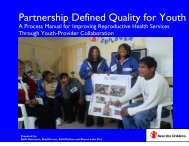

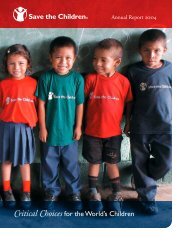
![View full document [PDF 3.39 MB] - PreventionWeb](https://img.yumpu.com/27308954/1/190x245/view-full-document-pdf-339-mb-preventionweb.jpg?quality=85)
